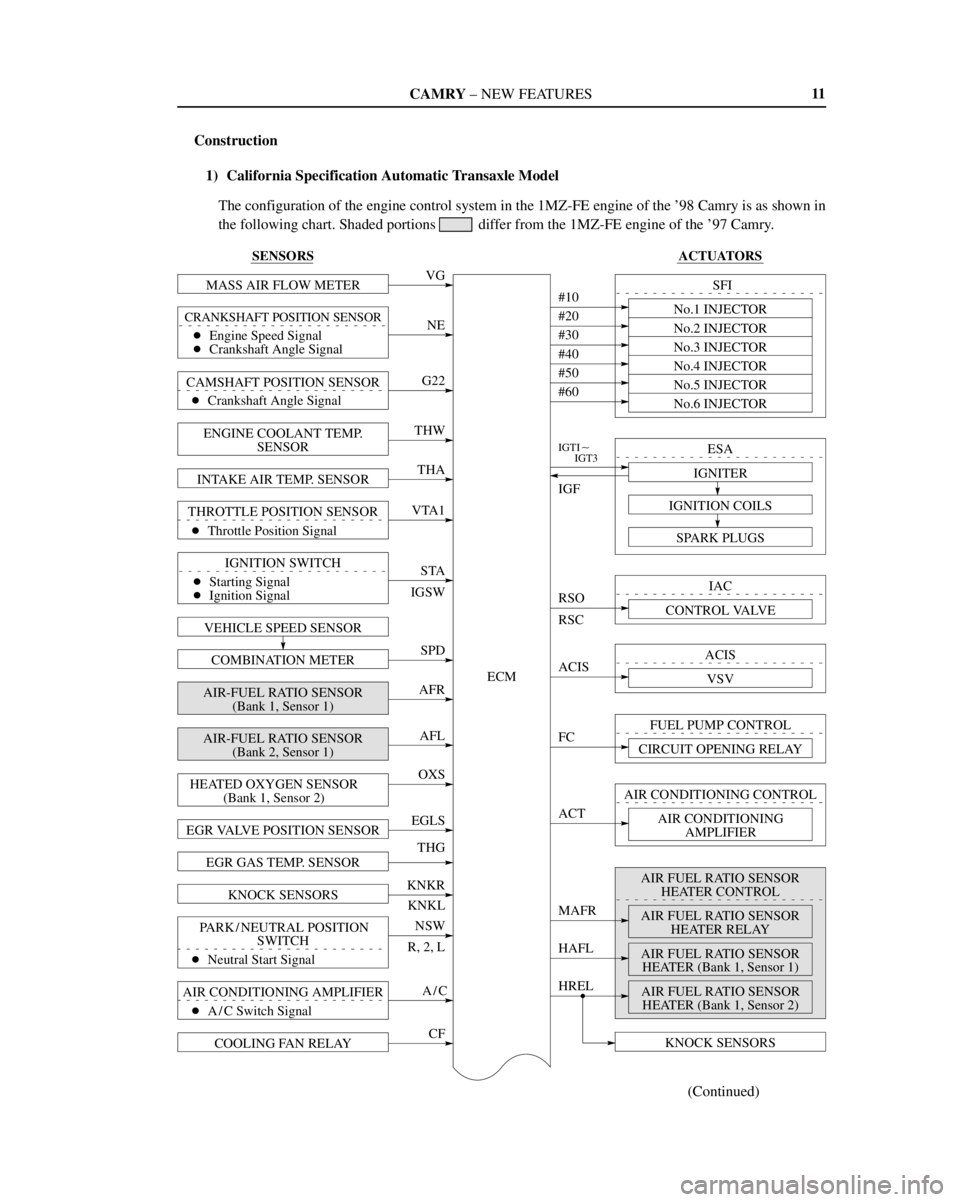Page 316 of 4770
ELECTRIC COOLING FAN INSTALLATION
(See Components for Removal and Installation)
1. INSTALL ELECTRIC COOLING FAN
(a) Install the cooling fan with the 4 bolts.
(b) Connect the engine coolant temperature switch and
electric cooling fan connectors to the fan shroud.
(c) Connect the engine coolant temperature switch connector
to the radiator.
2. CONNECT UPPER RADIATOR HOSE TO RADIATOR
3. w/ CRUISE CONTROL SYSTEM:
INSTALL CRUISE CONTROL ACTUATOR COVER
4. FILL WITH ENGINE COOLANT
(See page EG1±241)
5. CONNECT NEGATIVE (±) TERMINAL CABLE TO
BATTERY
6. START ENGINE AND CHECK FOR LEAKS
ELECTRIC COOLING FAN DISASSEMBLY
(See Components for Disassembly and Assembly)
1. REMOVE FAN
Remove the nut and fan.
ELECTRIC COOLING FAN ASSEMBLY
(See Components for Disassembly and Assembly)
1. INSTALL FAN MOTOR
2. INSTALL FAN 2. REMOVE FAN MOTOR
Remove the screws and fan motor.
± 5S±FE ENGINECOOLING SYSTEMEG1±266
Page 317 of 4770
SERVICE SPECIFICATIONS
SERVICE DATA
TORQUE SPECIFICATIONS
Valve opening temperature
Valve lift
Water bypass pipe x Water pump cover
Radiator oil cooler x Radiator lower tank Water pump x Water pump cover
No.2 idler pulley x Cylinder block Water inlet x Water pump coverRelief valve opening pressure
Water pump x Cylinder blockCylinder block x Drain plug
Water inlet x Water pump
Radiator oil cooler pipe
Radiator support boltElectric
cooling fanRotating amperage
Part tightened Radiator cap
Plate height Thermostat
Radiator
± 5S±FE ENGINECOOLING SYSTEMEG1±267
Page 511 of 4770

32ENGINEÐ5S±FE ENGINE
� MAJOR DIFFERENCES
Major differences between the new 5S±FE engine and previous engine are listed below.
Item
Features
Engine ProperThe squish area of the combustion chamber in the cylinder head has been
optimised to improve torque in the low±to mid±speed range.
Cooling SystemAn aluminum radiator core is used for weight reduction.
Intake and Exhaust System
�The ports of the manifold have been extended to improve torque in the low±
to mid±speed range.
�The exhaust manifold is made of stainless steel plates for improve engine per-
formance and weight reduction.
�Through the optimized allocation of the exhaust pipe supports, the number of
supports has been reduced from 5 to 4, thus reducing the noise and vibration
which are transmitted to the vehicle body.
Fuel SystemA fuel returnless system has been adopted to prevent the internal temperature
of the fuel tank from rising and to reduce evaporative emissions.
Ignition SystemThe DIS (Direct Ignition System) contributes to the powerful high output by
providing a powerful spark to the engine.
Engine MountingTo reduce noise and vibration and to improve drivability, the allocation of the
engine mounts*1 and their characteristics have been revised.
Engine Control System
�The injection pattern for engine starting have changed form the 2 group
injection type to sequential multiport injection type.
�In place of the oxygen sensor (bank 1, sensor 1), a new air fuel ratio sensor has
been adopted. *
2
�The power steering idle±up control has been changed from the system using
an air control valve to the one using a pressure switch and an IAC valve.
Emission Control System
�The EGR valve body has been changed from cast iron to aluminum alloy for
weight reduction.
�A TWC (Three±Way Catalytic Converter) that is integrated with a stainless
steel exhaust manifold has been adopted.*
2
�The TWC, which was previously installed below the exhaust manifold has
been discontinued.*3
*1: Only for Automatic Transaxle Models.
*
2: Only for California Specification Models.
*
3: Except for California Specification Models.
Page 525 of 4770

46ENGINEÐ1MZ±FE ENGINE
� MAJOR DIFFERNCES
Major differences between the new 1MZ±FE engne and previous engine are listed below.
Item
Outline
Cooling SystemAn aluminum radiator core is used for weight reduction.
Intake and Exhaust System
Through the optimized allocation of the exhaust pipe supports, the number
number of supports has been reduced from 5 to 4, thus reducing the noise
and vibration which are transmitted to the vehicle body.
Fuel SystemA fuel returnless system has been adopted to prevent the internal temperature
of the fuel tank from rising, and to reduce evaporative emissions.
Engine MountingThe characteristics of the engine mounts, torque rod, and absorber have been
optimized to reduce noise and vibration.
Engine Control System
�A communication circuit has been provided between the ECM and the
ABS & TRAC ECU in conjunction with the adoption of the TRAC
(Traction Control) system.*
�The fuel pressure control has been discontinued in conjunction with the
adoption of the fuel returnless system.
�Instead of using the IDL signal input from the throttle position sensor,
the ECM now uses the VTA signal to detect the completely closed state of
the throttle valve.
�A new EGR system which uses a EGR valve position sensor is used.
�A communication method of the ECM and the hand±held tester has been
changed from the SAEJ1962 to the ISO 9141±2.
*: Applicable only to Vehicle Equipped with the TRAC System.
Page 720 of 4770

CAMRY ± NEW FEATURES
No.2 INJECTOR
SENSORS ACTUATORS
VG
RSO IGF NE
ECM
IGTI�
IGT3
#10
G22
THW
THA
VTA1
STA
SPD
AFR
AFL
OXS
EGLS
THG
KNKR
CF
NSW
A/C
ACIS
FC
ACT
MAFR
HAFL
HREL
#20
#30
#40
#50
#60
MASS AIR FLOW METER
R, 2, L KNKLIGSW
RSC
CRANKSHAFT POSITION SENSOR
�Engine Speed Signal
�Crankshaft Angle Signal
CAMSHAFT POSITION SENSOR
�Crankshaft Angle Signal
ENGINE COOLANT TEMP.
SENSOR
INTAKE AIR TEMP. SENSOR
THROTTLE POSITION SENSOR
�Throttle Position Signal
IGNITION SWITCH
�Starting Signal
�Ignition Signal
VEHICLE SPEED SENSOR
COMBINATION METER
AIR-FUEL RATIO SENSOR
(Bank 1, Sensor 1)
AIR-FUEL RATIO SENSOR
(Bank 2, Sensor 1)
HEATED OXYGEN SENSOR
(Bank 1, Sensor 2)
EGR VALVE POSITION SENSOR
EGR GAS TEMP. SENSOR
KNOCK SENSORS
PARK / NEUTRAL POSITION
SWITCH
�Neutral Start Signal
AIR CONDITIONING AMPLIFIER
�A / C Switch Signal
COOLING FAN RELAYNo.1 INJECTOR
No.3 INJECTOR
No.4 INJECTOR
No.5 INJECTOR
No.6 INJECTOR
ESA
IGNITER
IGNITION COILS
SPARK PLUGS
IAC
CONTROL VALVE
ACIS
VSV
FUEL PUMP CONTROL
CIRCUIT OPENING RELAY
AIR CONDITIONING CONTROL
AIR CONDITIONING
AMPLIFIER
AIR FUEL RATIO SENSOR
HEATER CONTROL
AIR FUEL RATIO SENSOR
HEATER RELAY
AIR FUEL RATIO SENSOR
HEATER (Bank 1, Sensor 1)
AIR FUEL RATIO SENSOR
HEATER (Bank 1, Sensor 2)SFI
(Continued)
KNOCK SENSORS
11
Construction
1) California Specification Automatic Transaxle Model
The configuration of the engine control system in the 1MZ-FE engine of the '98 Camry is as shown in
the following chart. Shaded portions
differ from the 1MZ-FE engine of the '97 Camry.
Page 852 of 4770

'99camry U
86
The gauge indicates the engine coolant
temperature when the ignition switch is
on. The engine operating temperature
will vary with changes in weather and
engine load.
If the needle moves into the red zone,
your engine is too hot. If your vehicle
overheats, stop your vehicle and allow the
engine to cool.
Your vehicle may overheat during severe
operating conditions, such as:
�Driving up a long hill on a hot day.
�Reducing speed or stopping after high
speed driving.
�Idling for a long period with the air
conditioning on in stop±and±go traffic.
�Towing a trailer.
NOTICE
�Do not remove the thermostat in
the engine cooling system as this
may cause the engine to overheat.
The thermostat is designed to con-
trol the flow of coolant to keep the
temperature of the engine within
the specified operating range.
�Do not continue driving with an
overheated engine. See ºIf your ve-
hicle overheatsº in Part 4.
Tachometer
The tachometer indicates engine speed
in thousands of rpm
( revolutions per
minute). Use it while driving to select
correct shift points and to prevent en-
gine lugging and overrevving.
Driving with the engine running too fast
causes excessive engine wear and poor
fuel economy. Remember, in most cases
the slower the engine speed, the greater
the fuel economy.
NOTICE
Do not let the indicator needle get
into the red zone. This may cause
severe engine damage.
Engine coolant temperature
gauge
Page 910 of 4770

'99camry U
144
Heating
For best results, set controls to:
Fan speedÐAny setting except ºOFFº
TemperatureÐTo w a r d s WARM
(red zone)
Air intakeÐFRESH (outside air)
Air flowÐFLOOR
Air conditioningÐOFF
�For quick heating, select recirculated
air for a few minutes. To keep the
windows from fogging, select fresh af-
ter the vehicle interior has been
warmed.
�Press the ºA/Cº button on for dehumidi-
fied heating.
�Choose floor/windshield air flow to heat
the vehicle interior while defrosting or
defogging the windshield.Air conditioning
For best results, set controls to:
Fan speedÐAny setting except ºOFFº
TemperatureÐTo w a r d s COLD
(blue zone)
Air intakeÐFRESH (outside air)
Air flowÐPANEL
Air conditioningÐON
�For quick cooling, move the air intake
selector to recirculate for a few min-
utes.
Ventilation
For best results, set controls to:
Fan speedÐAny setting except ºOFFº
TemperatureÐTo w a r d s COLD
(blue zone)
Air intakeÐFRESH (outside air)
Air flowÐPANEL
Air conditioningÐOFF
Defogging
The inside of the windshield
For best results, set controls to:
Fan speedÐAny setting except ºOFFº
TemperatureÐTo w a r d s WARM
(red zone) to heat;
COLD (blue zone) to
cool
Air intakeÐFRESH (outside air)
Air flowÐWINDSHIELD
Turning the Air Flow Selector to wind-
shield position turns on the defroster to
clear the front view more quickly.
Press the ºA/Cº button for dehumidified
heating or cooling. This setting clears the
front view more quickly.
�On humid days, do not blow cold air
on the windshieldÐthe difference be-
tween the outside and inside tempera-
tures could make the fogging worse.
Page 924 of 4770
'99camry U
210
1. Power steering fluid reservoir
2. Engine coolant reservoir
3. Engine oil filler cap
4. Engine oil level dipstick
5. Brake fluid reservoir
6. Fuse blocks
7. Battery
8. Electric cooling fans
9. Windshield washer fluid tank
Engine compartment overview
�5S±FE engine